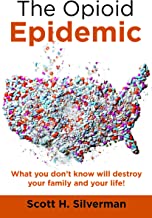The Opioid Epidemic by Scott Silverman; Right Turn Publishing, 2021; ISBN 9781736-745618; 177 pages including index, $19.95.
By Ben Dishman, Pharm.D

 SAN DIEGO — In a recent reading of the Scott Silverman book The Opioid Epidemic, this reader found the title a bit misleading. Rather than a book about the opioid epidemic the book was more a primer on overall strategies for the treatment of addiction.
SAN DIEGO — In a recent reading of the Scott Silverman book The Opioid Epidemic, this reader found the title a bit misleading. Rather than a book about the opioid epidemic the book was more a primer on overall strategies for the treatment of addiction.
Although I was confused by overestimated statistics describing the number of opioid-addicted individuals in this country, as I read further in the book, I realized Silverman was referring to the total number of individuals who may at one time had a substance abuse issue in the United States whether that be with opioids, alcohol, narcotics, street drugs, or other substances.
Silverman is well known in San Diego, where he has made a career through the Second Chance program helping addicted individuals to recover, and then find employment and make their way back into society
He describes some of the quandaries that cities, states and countries face when considering the legalization of illicit substances. He also raises the issue of comorbidity (when the individual has more medical problems than just an addiction) and how other less dangerous drugs can lead to narcotic (such as heroin) abuse.
I got the impression that the author was discouraging the use of narcotics in clinical practice. In many cases I have found that recent headlines discouraging their use, leads to many patients living in fear of addiction and thereby living with unnecessary pain and its resultant depression and lower quality of life. Improper prescribing of narcotics can lead to addiction but proper use should not be discouraged.
Readers with limited knowledge of addiction will find the book useful as it provides signs and symptoms to look for that may indicate that you, your child or other family member may be at risk of addiction. Also useful is the information provided that lays out possible treatment strategies and organizations that can be contacted for help with addiction issues.
I personally would find it useful if in future editions of this book the author would include some statistics from studies of different treatment options and the final outcomes of those studies.
Overall I found that the book would be useful for anyone trying to navigate his or her way through the pain of watching a loved one struggling with addiction. The author lets readers know they are not alone and provides logical alternative strategies for dealing with the addiction.
*
Ben Dishman prior to his retirement served as the senior psychiatric pharmacist at the VA Hospital in La Jolla, California. He is the author of I Can Fix That … Well, Maybe, describing treatment strategies and medications for individuals with mental illnesses.